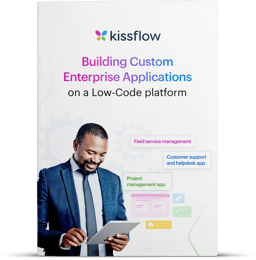
- >
- Application Development >
- What is Agile Application Development? Advantages & Best Practices
What is Agile Application Development? Advantages & Best Practices
Agile is a methodology that promotes adaptive planning, evolutionary development, and continual improvement by fostering a collaborative team environment. It puts a premium on flexibility, enabling your teams to respond swiftly to changes without jeopardizing app release dates. This approach can lead to a reduction in technical debt, delivery of higher-quality apps, and improved customer satisfaction.
One key aspect of Agile application development is its emphasis on lean processes and the creation of a Minimum Viable Product (MVP). Rather than striving for perfection right out of the gate, your teams will focus on developing an MVP and then progressively refining it through several iterations based on feedback.
With Agile, your teams work collaboratively towards a common goal, gathering and implementing feedback continuously. This iterative process streamlines development and ensures that the final product is well-aligned with user needs and expectations.
Incorporating Agile methodology into your application development strategy can significantly improve your organization's efficiency, quality, and responsiveness to change.
What is agile application development?
Agile is an iterative software application development that ensures developers deliver value to users faster. Work is delivered in small but consumable increments and not put together for a "big bang" launch. The app development methodology anticipates the need for flexibility and applies rationality to the delivery of the finished product. It focuses on the clean delivery of individual pieces of the application and not on the entire application.
Agile helps teams in an evolving business landscape to maintain focus on the efficient delivery of business value. It facilitates a collaborative culture and improves efficiency throughout an organization because teams understand their specific roles and work together.
Additionally, companies using the Agile methodology feel confident about their applications since testing is performed throughout development. Changes are made as needed, and teams quickly tackle issues as they arise. In many companies, Agile has replaced Waterfall as the development methodology of choice.

Explore the Benefits of Low-Code Platforms: Speed Up App Development, Achieve Digital Goals
Thank you for downloading
The difference between agile and traditional app development
Traditional application development methodologies like Waterfall use a predictive approach. They are fully predictable, and applications are built through meticulous planning. Changes are not allowed as the project timeline and cost are fixed. The Agile app development methodology uses an adaptive approach. It’s based on the principle of continuous design improvement. At least 71% of U.S. companies are now using Agile.
Traditional app development methodologies are more suitable for less complex projects. Since they have a linear approach, sudden changes can interrupt the whole development process. On the contrary, Agile application development is ideal for complex projects. Continuous changes do not affect app development since frequent testing is done through iteration. This frequent testing enables the team to improve the application without restarting the development process all over again.
Learn more: Enterprise Application Development: A Complete Overview
Advantages of building applications the agile way
Research indicates that businesses that adopt the agile methodology experience a 98 percent rate of success and 60 percent more profit than companies that lean towards the traditional approach.
High quality
Agile uses an iterative approach to app management, so processes are improved upon with each iteration. Continuous improvement and quality control are two core principles of Agile that help create superior products.
The Agile application development methodology is also based on feedback and collaboration. Developers can find and fix bugs quickly and optimize the code to improve an app’s quality in real-time.
Flexible
Agile app development is all about flexibility. Changes are expected and aren’t as costly and time-consuming as they are for traditional app development. As requirements and priorities change, the application is changed and adapted to the current market situation.
Learn more: Build Custom Application Development Solutions Faster than Ever
Risk reduction
Agile is also a risk-reducing methodology. Continuous collaboration ensures everyone understands the project goals and works towards them. The approach is focused on the value delivered after each sprint so teams respond to new demands quickly and more effectively. In traditional app development, requirements are only collected at the beginning, and regular feedback isn’t needed.
Visibility and transparency
Agile makes the project visible to all stakeholders at all times. Everyone can observe the progress and give feedback. And because the approach relies on the end users’ involvement throughout the project, it provides more transparency for all parties involved.
End-user experience
Agile puts a big emphasis on delivering value to the application’s end-users. Features are based on acceptance criteria—conditions they have to satisfy to be accepted by the end users. Agile delivers value after each sprint. New features are available for feedback in real-time and are changed and polished to meet users’ expectations faster.
Learn more: enterprise low-code development platform
Continuous improvement
Agile teams hold regular meetings to discuss what they’re doing well, what needs to be improved, and what needs to be eliminated. They identify mistakes through continuous collaboration and don’t repeat them in the future. Agile promotes a spirit of continuous improvement, which is one of its core principles.
Learn how industry leaders transformed with our platform.
Agile application development best practices
Meeting requirements
End users are happy when their requirements are fulfilled, expectations are met, and wants, and needs are gratified. Agile teams must know what end users want and deliver exactly that. They must be in constant communication with the end users to clarify expectations, collaborate on fixes, and explore options not previously considered. Frequent interaction promotes creativity and boosts app quality.
Learn more: Everything You Need To Know About Web Application Development In 2023
Collaboration
Agile teams understand that individuals accomplish more when they rely on each other, not processes and tools. Collaboration empowers teams to be more creative and produces truly innovative applications. Every member of the team can contribute their knowledge and skills to deliver successful project outcomes.
Task prioritization
Prioritizing tasks is an essential aspect of Agile app development. There are different methods for achieving this (like first-in/first-out), and agile teams must do some trial and error to choose the right task prioritization model. As the nature of work changes and the team evolves, it may be necessary to switch approaches altogether.
Proper sprint setup
Sprints are limited periods when agile teams collaborate to complete a set amount of work. Tasks are arranged in order of importance, and each team member has responsibilities aligned with each task. Setting up sprints properly is essential. There must be enough tasks to fill up the sprint, but not too many that the team risks losing focus and edging into scope creep.
The agile app development process
Agile application development consists of short development cycles (2–3 weeks each) that minimize risk. The end-user can see the result after each sprint and request changes. In this way, they control app development. Each Agile app development process comprises the following stages:
- Requirements analysis
- Design
- Development
- Testing
- Deployment
- Review
How to adapt agility to build apps
Collaborate effectively
Agile teams are empowered and work autonomously through self-organization and cross-functionality. But for projects to be well coordinated, there must be high levels of collaboration. Maintaining collaboration throughout a development project takes a lot of effort and commitment. Different Agile systems have tools designed to help teams maintain a high level of collaboration, like Kanban and Scrum boards.
Avoid scope creep
Many benefits of Agile are a direct result of the flexibility it offers. But since the next iteration is always informed by previous releases and feedback loops, there is never a clear vision of the final product. Frequent changes can lead to loss of focus and scope creep. Teams may miss deadlines and have difficulty knowing what to track progress against. To avoid scope creep, there must be:
- A clear outline of priorities for an iteration
- Sufficient information support for high-priority tasks
- Goals that define the scope of an iteration
- A system that keeps new requests in view
How Kissflow can help
Agile is one of the most popular and in-demand software development methodologies,, and many organizations have adopted it. Kissflow is a low-code platform that supports agile online app development platform. It lets your teams collaborate, iterate, test, and build high-quality applications. You can now build better, more functional enterprise applications from scratch without burdening your IT teams. See Kissflow in action.
More Resources:
- Custom Business App
- How to Create a Web App
- Custom Application Development
- Custom Application Development Services
- Custom Web Application Development
- How to Create an App Without Coding
- Custom App Development Software
Discover how the Kissflow Low-Code App Development platform can streamline your development process.
Frequently Asked Questions (FAQs)
What are the key benefits of Agile app development?
Key benefits of Agile app development include faster time-to-market through iterative delivery, higher quality through continuous testing, improved stakeholder satisfaction from regular feedback, greater flexibility to adapt to changing requirements, reduced project risk through incremental development, better team collaboration, and more accurate alignment with user needs through ongoing validation.
How does Agile compare to other development methodologies?
Agile compares to other methodologies through its iterative approach versus Waterfall's linear progression, emphasis on working software over documentation, adaptive planning versus predictive planning, continuous stakeholder involvement throughout development, shorter delivery cycles, and greater flexibility to incorporate changing requirements without disrupting the entire project plan.
What are best practices for Agile software development?
Best practices for Agile software development include maintaining small, cross-functional teams, holding daily stand-up meetings for alignment, breaking work into manageable sprints, prioritizing backlog items by business value, automating testing to maintain quality, conducting regular retrospectives for process improvement, involving stakeholders continuously, and measuring progress through working software rather than documentation.
How do businesses implement Agile successfully?
Businesses implement Agile successfully by securing executive sponsorship and understanding, providing proper training and coaching, starting with pilot projects to demonstrate value, creating dedicated cross-functional teams with decision authority, establishing appropriate physical or virtual collaboration spaces, implementing supporting tools, focusing on delivering customer value, and allowing teams to adapt practices to their specific context.
What are common challenges in Agile application development?
Common challenges in Agile application development include resistance to changing from traditional approaches, difficulties scaling beyond small teams, maintaining technical quality while delivering quickly, managing dependencies between teams, handling fixed-scope contracts, balancing documentation needs, incorporating security throughout the development lifecycle, and sustaining stakeholder engagement throughout longer projects.
How does Agile improve application development outcomes in enterprises?
Agile enables faster delivery by breaking work into small increments, allowing teams to refine functionality based on continuous feedback. This reduces risk, improves usability, and ensures that apps evolve alongside changing business needs.
Why is Agile well-suited for low-code app development?
Low-code accelerates each Agile sprint by reducing development effort, shortening iteration cycles, and enabling rapid prototyping. Teams can build, test, and adapt workflows much faster than in code-heavy environments.
How does Agile improve collaboration between IT and business teams?
Frequent reviews, daily interactions, and shared ownership ensure stakeholders shape the evolving product. This alignment reduces misunderstandings and improves adoption after deployment.
What challenges arise when scaling Agile for enterprise applications?
Large organizations may struggle with cross-team coordination, integration dependencies, governance consistency, and prioritization. Agile success requires strong leadership, clear standards, and adaptable tooling.
How can CIOs measure Agile success in application development?
Cycle-time reduction, sprint predictability, user satisfaction, backlog burn-down rates, and production stability all indicate how well Agile is working.
Related Articles











